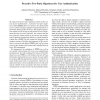186 search results - page 11 / 38 » Signature Schemes Based on the Strong RSA Assumption |
112
Voted
SCN
2004
Springer
15 years 5 months ago
2004
Springer
Chameleon signatures were introduced by Krawczyk and Rabin, being non-interactive signature schemes that provide non-transferability. However, that first construction employs a c...
91
Voted
CHES
2003
Springer
15 years 4 months ago
2003
Springer
Abstract. Efficient implementations of RSA on computationally limited devices, such as smartcards, often use the CRT technique in combination with Garner’s algorithm in order to ...
97
Voted
INFORMATICALT
2010
14 years 9 months ago
2010
In 2007, Kancharla et al. proposed an identity-based strong designated verifier signature (IBSDVS) scheme based on bilinear pairings, and claimed it unforgeable and non-delegatable...
CRYPTO
2000
Springer
15 years 4 months ago
2000
Springer
Abstract. Non-committing encryption enables the construction of multiparty computation protocols secure against an adaptive adversary in the computational setting where private cha...
113
Voted
NDSS
2003
IEEE
15 years 5 months ago
2003
IEEE
We study proactive two-party signature schemes in the context of user authentication. A proactive two-party signature scheme (P2SS) allows two parties—the client and the server�...

